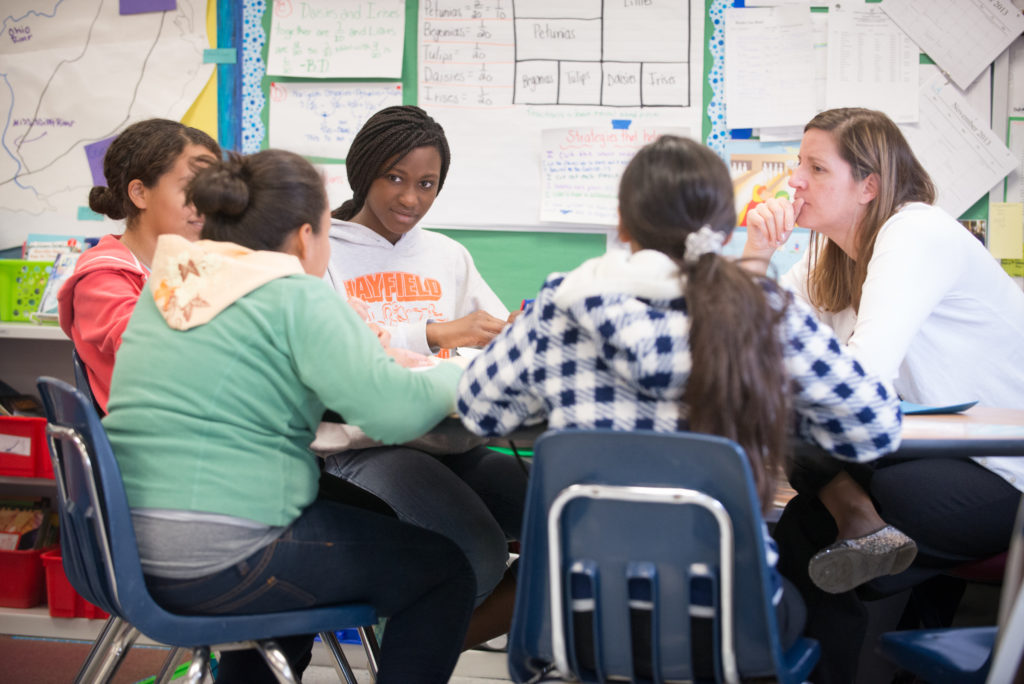Children learn a great deal, academically and socially, by collaborating—working together toward common goals. A good way to help students begin developing collaboration skills is by teaching them how to exchange ideas, information, and opinions as they converse with partners or in small groups.
Partner and small-group chats require complex skills best taught in the context of a positive classroom community in which all students feel safe, included, and respected. Working with students to establish classroom rules, using positive teacher language, helping students get to know each other by inviting them to share news and opinions in Morning Meeting or Responsive Advisory Meeting and at other times throughout the day—these are all strategies you can use to establish a positive learning community.
Once you’ve begun building your community, you can also start teaching students about partner and small-group chats. Here’s a plan for how you could stage that teaching.
Starting Out
- Pair students up and begin teaching them how to take turns speaking and listening— a key communication skill for partner and small-group chats (see box). Interactive Modeling is a great strategy for teaching this and other classroom skills and routines.
- Give students frequent opportunities for brief partner chats.
- Assign partners (or simply draw names), but vary the partnerships often.
Communication Skills for Partner and Small Group Chats
- Face the speaker
- Keep your eyes on the speaker
- Look at the people you’re speaking to
- Use supportive body language and facial expressions
- Listen for (and remember) key details
- Summarize the speaker’s sharing
- Take turns listening and speaking
- Use confident body posture
- Stay on topic
- Speak clearly and concisely in complete sentences
- Use appropriate volume when speaking
- Ask purposeful questions
- Make helpful comments
Getting Comfortable
- Gradually, as appropriate to students’ age and skill level, introduce new skills, such as summarizing the speaker’s sharing and asking purposeful questions.
- Continue offering many opportunities for partner chats so that students can solidify their learning and get comfortable talking with various classmates.
- Reteach earlier skills as needed.
- To making switching partners efficient (and enjoyable), try an interactive learning structure such as Matching Cards: Write numbers on index cards and have students pair up with the classmate who has the same number as they do.
- Or try Inside-Outside Circles, a fun strategy that lets children pair up with several partners in just a few minutes. (Students stand in two concentric circles, those in the inner circle facing those in the outer, and facing pairs chat. Then one circle moves to the right and students chat with a new partner.
Moving On
- When students are ready, move from partner chats to groups of three or four.
- Teach, model, and practice the additional skills needed for this more complex structure: Deciding on a three-way or four-way turn-taking order, shifting bodies and eyes from speaker to speaker, patiently waiting longer for a turn to speak.
- To keep the classroom climate supportive as students develop these new skills, continue to facilitate groupings (whether by assignment or random choice—draw names or have students count off by threes or fours).
- Once students seem comfortable in groups, give students opportunities to choose their own chat partners or small-groups (once you’ve taught, modeled, and practiced how to do so efficiently and considerately).
Throughout the Year
- Carefully observe students’ developing collaboration skills.
- Offer explicit feedback on what they’re doing well: “I notice that you’re keeping your eyes on your partners even when it’s not your turn to speak.”
- Coach them respectfully if they veer off course, reteach as needed, and introduce new skills and larger groups as they’re ready.
More on Partner and Small-Group Chats
Enjoyed reading it? Spread the word
Written by
Responsive Classroom
Download PDF
